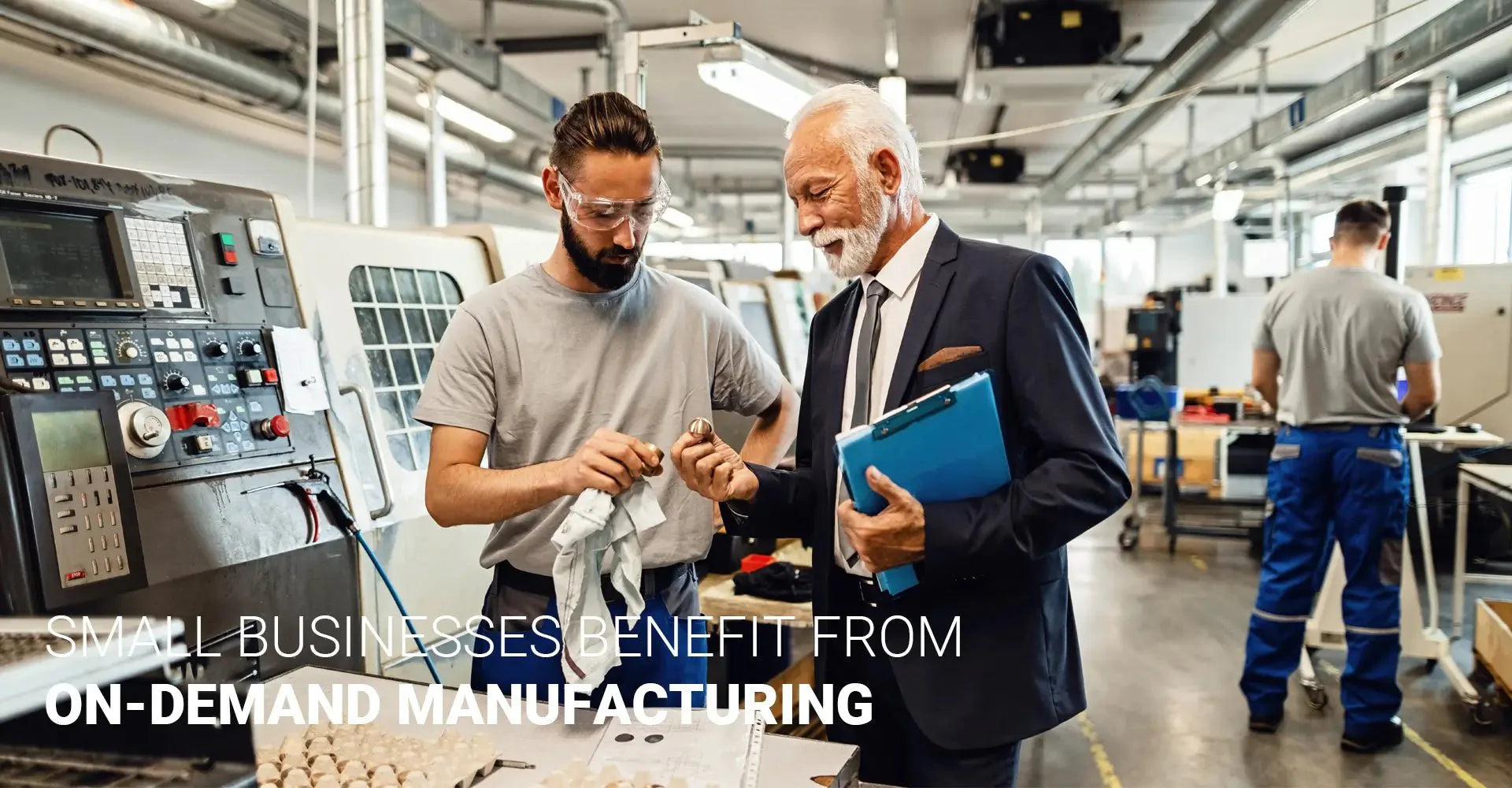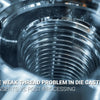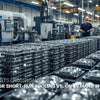How Can Small Businesses Benefit from On-Demand Manufacturing in 2025?

How Can Small Businesses Benefit from On-Demand Manufacturing in 2025?

In today's competitive business landscape, small businesses are discovering that on-demand manufacturing offers a practical solution to their production challenges. This approach allows companies to manufacture products only when needed, eliminating excessive inventory costs while maintaining high quality and customization options.
On-demand manufacturing enables small businesses to reduce inventory costs by up to 30% while offering customized products without significant upfront investment. This manufacturing method is particularly valuable for companies producing specialized components or limited product runs.
Before diving into the specific benefits and applications of on-demand manufacturing, it's important to understand how this approach differs from traditional manufacturing methods and why it's becoming increasingly popular among small business owners.
[Table of Contents]
- What Makes On-Demand Manufacturing Different from Traditional Production Methods?
- Which Industries Are Successfully Using On-Demand Manufacturing Today?
- How Does the Cost Structure of On-Demand Manufacturing Work?
- What Technology Drives Modern On-Demand Manufacturing?
- What Are the Real Challenges in Implementing On-Demand Manufacturing?
- How Does On-Demand Manufacturing Impact Inventory Management?
- What Makes On-Demand Manufacturing Environmentally Responsible?
What Makes On-Demand Manufacturing Different from Traditional Production Methods?
The fundamental difference lies in the approach to production timing and batch sizes. Traditional manufacturing typically requires large production runs to achieve economies of scale, while on-demand manufacturing focuses on producing items as they're ordered.
When comparing these methods, on-demand manufacturing stands out for its flexibility and responsiveness to market demands. This approach eliminates the need for large warehouses filled with inventory and reduces the risk of obsolete stock.
The key distinctions become clear when examining the production workflow. While traditional manufacturing might require minimum order quantities of thousands of units, CNC machining services can produce single parts or small batches with equal efficiency. This capability makes it particularly valuable for businesses needing precise, custom components.
Which Industries Are Successfully Using On-Demand Manufacturing Today?
On-demand manufacturing has found success across various sectors, from automotive parts to consumer goods. Industries requiring rapid prototyping or custom components have been particularly quick to adopt this approach.
A notable example is the medical device industry, where 3D printing enables the production of custom prosthetics and medical tools. Similarly, the automotive aftermarket sector uses on-demand manufacturing for replacement parts and custom components.

The versatility of on-demand manufacturing is evident in how different industries utilize various techniques. For instance, die casting serves industries needing durable metal parts, while sheet metal fabrication caters to businesses requiring custom metal components.
How Does the Cost Structure of On-Demand Manufacturing Work?
Understanding the cost implications helps businesses make informed decisions about their manufacturing approach. While initial setup costs might seem higher, the long-term financial benefits often outweigh the investment.
The cost structure breaks down into several key components: equipment investment, material costs, labor, and operational expenses. One significant advantage is the ability to adjust surface finishes according to specific requirements, which can impact both cost and quality. Learn more about various surface finish options and their cost implications.
A deeper analysis reveals that while per-unit costs might be higher for small batches, the total cost of ownership is often lower due to reduced inventory expenses, minimal waste, and eliminated storage costs. Small businesses particularly benefit from the ability to scale production up or down without significant financial penalties.
Let's dive deeper into the specific cost components:
- Initial Technology Investment
- CAD/CAM software licensing: $2,000-$15,000 annually
- Quality control systems: $5,000-$50,000
- Production equipment setup: Varies by technology
- CNC machinery: $50,000-$200,000
- 3D printers: $5,000-$100,000
- Die casting equipment: $25,000-$150,000
- Material Costs
- Raw material inventory: 20-30% lower than traditional manufacturing
- Waste reduction: 15-25% improvement over traditional methods
- Material versatility costs:
- Specialty metals: Premium of 10-30%
- Custom polymers: Premium of 15-40%
- Labor and Expertise
- Skilled operator costs: $25-$45 per hour
- Programming and design: $40-$80 per hour
- Quality control personnel: $30-$50 per hour
- Operational Expenses
- Energy consumption: 15-30% lower than mass production
- Maintenance costs: 5-10% of equipment value annually
- Surface finishing costs: $10-$100 per piece depending on complexity
- Economies of Scale Considerations
- Small batch premium: 10-30% higher per unit
- Setup cost amortization: Spread across smaller quantities
- Flexibility premium: 5-15% for rapid changeovers
What Technology Drives Modern On-Demand Manufacturing?
The backbone of on-demand manufacturing lies in advanced digital technologies that enable precise, repeatable production processes. These technologies continue to evolve, making production more accessible and efficient for businesses of all sizes.
Central to this evolution is the integration of CNC machining and 3D printing technologies, which offer unprecedented flexibility in producing complex parts. These systems allow for rapid switching between different products without extensive retooling.

The technological ecosystem extends beyond just production equipment. Modern on-demand manufacturing incorporates advanced design software, quality control systems, and automated workflow management tools. This integration ensures consistent quality while maintaining the flexibility that makes on-demand manufacturing attractive.
Core Technologies and Their Applications:
- Digital Design and Simulation
- Advanced CAD/CAM systems
- Digital twin technology
- Virtual prototyping platforms
- Real-time simulation capabilities
- 5-axis machining centers
- High-speed cutting capabilities
- Automated tool changing systems
- Precision control systems (±0.001mm accuracy)
- Advanced cutting tool technologies
- Multi-material printing capabilities
- Metal powder bed fusion
- Continuous carbon fiber reinforcement
- High-speed resin systems
- Large format printing solutions
- Computer-controlled injection systems
- Real-time monitoring capabilities
- Advanced thermal management
- Automated release systems
- Automated bending systems
- Precision laser cutting
- Robotic welding integration
- Smart material handling
- Quality Control Systems
- In-line inspection systems
- 3D scanning technology
- Machine learning-based quality prediction
- Real-time process monitoring
- Automated defect detection
- Integration Technologies
- Internet of Things (IoT) sensors
- Cloud-based production management
- Real-time data analytics
- Predictive maintenance systems
- Supply chain integration platforms
- Automated finishing systems
- Precision coating applications
- Environmental control systems
- Surface quality monitoring
- Automation and Robotics
- Collaborative robots
- Automated material handling
- Smart storage systems
- Vision-guided systems
- Flexible manufacturing cells
- Software Integration
- ERP system integration
- Digital workflow management
- Real-time production scheduling
- Customer portal integration
- Quality management systems
What Are the Real Challenges in Implementing On-Demand Manufacturing?
While on-demand manufacturing offers numerous benefits, businesses must navigate several challenges during implementation. Understanding these challenges helps in developing effective strategies to overcome them.
Common hurdles include initial technology investment, staff training, and quality consistency across small batches. For instance, achieving consistent surface finishes across different production runs requires careful process control and expertise.
The key to overcoming these challenges lies in careful planning and choosing the right manufacturing partners. Many businesses find success by starting with simpler projects and gradually expanding their on-demand manufacturing capabilities as they gain experience.
How Does On-Demand Manufacturing Impact Inventory Management?
The relationship between on-demand manufacturing and inventory management represents a significant shift from traditional approaches. This modern method dramatically reduces the need for large inventory holdings while maintaining service levels.
By implementing die casting and sheet metal fabrication on demand, businesses can maintain minimal inventory while ensuring quick response times to customer orders. This approach particularly benefits companies dealing with customized or specialized products.
The impact extends beyond just storage space savings. On-demand manufacturing enables better cash flow management, reduced obsolescence risk, and improved ability to respond to market changes quickly.
What Makes On-Demand Manufacturing Environmentally Responsible?
Environmental responsibility has become increasingly important in manufacturing decisions. On-demand manufacturing offers several environmental benefits that align with modern sustainability goals.
This approach significantly reduces waste through precise production quantities and the ability to use materials more efficiently. Technologies like 3D printing and CNC machining optimize material usage, minimizing environmental impact.
By producing only what's needed, when it's needed, businesses can significantly reduce their carbon footprint while maintaining productivity and meeting customer demands.
Conclusion
On-demand manufacturing represents a significant advancement in how small businesses approach production. By combining flexibility, cost-effectiveness, and environmental responsibility, it offers a compelling solution for modern manufacturing needs.
Key Takeaways
- Reduced inventory costs and improved cash flow
- Greater flexibility in product customization
- Environmental benefits through reduced waste
- Improved response time to market demands
- Lower risk of obsolete inventory
External Links and Resources
-
Posted in
On-demand Manufacturing





